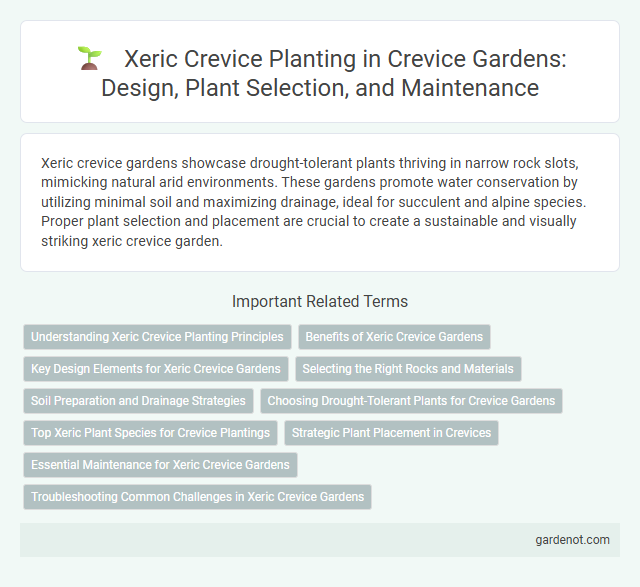Xeric crevice gardens showcase drought-tolerant plants thriving in narrow rock slots, mimicking natural arid environments. These gardens promote water conservation by utilizing minimal soil and maximizing drainage, ideal for succulent and alpine species. Proper plant selection and placement are crucial to create a sustainable and visually striking xeric crevice garden.
Understanding Xeric Crevice Planting Principles
Xeric crevice planting principles center on replicating natural dry rock fissures where drought-tolerant plants thrive with minimal water. This technique emphasizes well-drained, gritty substrates and narrow, deep crevices that facilitate root establishment while reducing moisture retention, crucial for succulents and alpine species. Proper sun exposure and microclimate simulation enhance plant resilience and long-term sustainability in xeric crevice gardens.
Benefits of Xeric Crevice Gardens
Xeric crevice gardens offer exceptional water efficiency by mimicking natural arid environments, reducing irrigation needs and conserving resources. These gardens promote drought-resistant plant growth, fostering biodiversity with minimal maintenance requirements. Enhanced soil drainage in crevice designs prevents root rot, ensuring healthier, longer-lasting plant life in xeric conditions.
Key Design Elements for Xeric Crevice Gardens
Xeric crevice gardens rely on narrow, deep fissures filled with fast-draining, sandy or gritty soil to mimic natural rock formations and support drought-tolerant plants. Strategic placement of rocks creates microclimates, providing both shade and sun exposure that optimize moisture retention and root growth. Incorporating native succulent and alpine plant species enhances resilience, requiring minimal water while thriving in the harsh, dry conditions of xeric environments.
Selecting the Right Rocks and Materials
Selecting the right rocks and materials for a xeric crevice garden is essential to mimic natural arid environments. Choose durable, weather-resistant stones such as sandstone, slate, or limestone that provide deep, narrow crevices for drought-tolerant plants to root and thrive. Incorporate coarse gravel or grit to improve drainage and prevent water retention, ensuring optimal growing conditions for xerophytes.
Soil Preparation and Drainage Strategies
Xeric crevice garden soil preparation requires well-draining, sandy or gritty soil mixed with organic matter to mimic natural xeric environments. Incorporating coarse sand, decomposed granite, or small gravel enhances drainage, preventing water retention that can lead to root rot. Elevated crevices and sloped substrates further improve water runoff, ensuring plants thrive in arid conditions.
Choosing Drought-Tolerant Plants for Crevice Gardens
Choosing drought-tolerant plants for xeric crevice gardens involves selecting species adapted to minimal water and extreme moisture fluctuations, such as sedums, sempervivums, and thyme. These plants thrive in narrow rock fissures with well-drained soil and limited root space, ensuring resilience during dry spells and intense sunlight exposure. Prioritizing native, drought-resistant succulents and perennials enhances garden sustainability and reduces irrigation needs while maintaining aesthetic appeal.
Top Xeric Plant Species for Crevice Plantings
Top xeric plant species for crevice garden plantings include Sempervivum (hens and chicks), Sedum (stonecrop), and Lithops (living stones), all adapted to thrive in minimal soil with excellent drought resistance. These plants exhibit strong root systems that anchor securely in narrow rock fissures, enabling survival in arid conditions with limited water retention. Incorporating species like Delosperma (ice plant) and Alyssum montanum enhances biodiversity and provides vibrant seasonal color while maintaining the low-maintenance character of xeric crevice gardens.
Strategic Plant Placement in Crevices
Strategic plant placement in xeric crevice gardens enhances water conservation and mimics natural drought-resistant environments by selecting species adapted to minimal moisture and intense sunlight. Deep-rooted succulents and drought-tolerant perennials are ideally positioned within narrow crevices to maximize soil retention and reduce evaporation. This intentional spatial arrangement promotes healthy growth while sustaining the garden's ecological balance and aesthetic appeal.
Essential Maintenance for Xeric Crevice Gardens
Xeric crevice gardens require essential maintenance such as regular inspection for debris and invasive weeds that can disrupt drainage and plant health. Soil should be monitored to maintain its well-draining properties, ensuring water does not accumulate in the crevices. Pruning dead or overgrown vegetation helps sustain airflow and prevents fungal growth, crucial for xeric plant survival.
Troubleshooting Common Challenges in Xeric Crevice Gardens
Xeric crevice gardens often face challenges such as poor drainage, which can lead to root rot in drought-tolerant plants like sedums and sempervivums. Ensuring rock placement allows for proper air circulation and water runoff is essential to prevent waterlogging in narrow crevices. Addressing soil pH imbalances and eliminating competition from invasive weeds can improve plant health and overall garden resilience.
Xeric crevice Infographic

 gardenot.com
gardenot.com